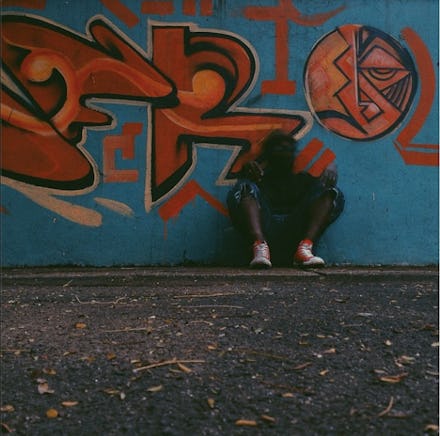Thanks to Instagram, African Art Is Finally Getting the Spotlight

The African art revolution will be Instagrammed.
It's clear that in popular and academic art history discussions, and even in professional art industries, coverage of African art and artistic movements is inadequate. Go to any nonspecialized art museum or read any art historical survey book for proof.
It's also no secret that European art is more well-known to the average American viewer than African art. From the high Renaissance to impressionism, European art is more deeply established in the cultural consciousness — particularly in the West. General knowledge of African art begins with ancient Egypt and ends with carved tribal masks; this is reductive at best, and ignorant at worst. Instagram, of all things, is helping to change that.
Ghanaian photographer Nana Kofi Acquah, @africashowboy, creates colorful, vibrant photographs that often have a socially conscious element. He describes himself as a storyteller.
For African artists, like Ghanaian photographer Nani Kofi Acquah and South African designer Kevin-Tumba Makonga, Instagram provides a unique opportunity to showcase their art on a global scale. Not the art favored by tourists or selected for Western audiences, but on-the-ground photography that, thanks to Instagram, is getting the global spotlight that the region has been denied for far too long.
Guillaume Bonn, @guillaumebonn, is a French-Malagasy photographer and photojournalist. Though he was born in Madagascar, he has lived and worked across Africa for his compelling photographic series.
Typically, discussion and presentation of African art movements is washed in Eurocentric postcolonialism. Most modern and contemporary African visual artists are described as "crosses" between traditional motifs and traditions and imposed or adopted Western aesthetics. And despite a recent upswing in collector interest, African art is still considered an emerging market for collectors. Instagram, though, is making this exceptional art accessible to anyone with an Internet connection.
Mwangi Kirubi, @mwarv, is on a mission to showcase the beautiful, the joyous and the inspiring stories in Africa. His work is playful and smart, and Kirubi is always aware of the larger narrative.
Why does it matter that art in Africa has a presence in the cultural consciousness? Why should we care if African art is excluded from the art history conversation, or the pop culture conversation?
Andile Buka, @buka_andile, is a South African photographer whose portraiture shines. He's based in Johannesburg, and that city's energy pervades his images.
Because African art and artists are underexposed. Phenomenal artists, like Papa Ibra Tall, and traditions, like Senegalese film and Ndebele painting, aren't as well-known as works of their quality should be. Because African art is underexposed, it may also be underappreciated, undervalued and misunderstood.
kevin-tumba Makonga, @kotasandcaviar, is another impressive South African artist. He is a graphic designer, unlike many of the others here, who are photographers.
In measurable terms, that lack of exposure could translate to: fewer museum and gallery exhibitions that might raise awareness; fewer interested collectors to support the existing art communities and fuel growth of the art industry in Africa; less revenue from art tourism to the cities and countries that may be connected to these artists; and fewer opportunities for emerging and established African artists.
Sam Vox, @sam.vox. It's beautiful to see this kind of conceptual serenity in portraiture. His city and landscape shots exude a similar peace..
Instagram can help change this.
In the past, the art world elite would have defined the new trends in art and culture. With the rise of social media, African artists can show the world their work without needing museums or collectors. Of course, Instagram doesn't allow artists to directly sell their pieces, but it gives artists a platform on which to share their art with a broader audience.
Lindokuhle Nkosi, @lindokushle, is an artist whose imagery is moody and intensely felt. Images of her recent travels through Senegal and Mauritania are particularly compelling.
This is not an anarchical dance party on the graves of the art world Illuminati. It's simply a note that social media is increasing access to art around the world and opening the floor for artistic discussion. In this way, Instagram has the potential to redefine how and when art gets exposure around the world.
In sub-Saharan Africa, mobile phone use grows by nearly 18% a year while social media use spreads, although mobile phone use in rural areas is still around 33%.
That being said, Instagram is raising the artistic profile of otherwise unknown African artists and increasing exposure to a strong artistic community. The photographic tradition is well-represented in Africa, and includes luminaries like the ground-breaking Malian photographers Malick Sidibe and Seydou Keita. That history makes Instagram a particularly compelling outlet.
Alessio La Ruffa, @alessiolr, is another Johannesburg-based photographer and young creative making waves. His work emphasizes spatial relationships and perspective.
In the art world, the value of traditional authority is diminishing while the value of the people's choice is increasing.
Mutua Metheka, @truthslinger, is a Kenyan photographer and designer. It's easy to see why so many people are drawn to his work.
Even if the art historians and elite do not direct their spotlight onto Africa's artistic culture, African artists are seizing the social media chance to direct it there themselves.